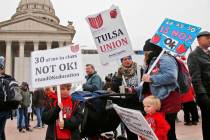In the eye of affluence: High-end suburbs not out of reach of valley’s homeless issue
His home is a one-minute walk to Summerlin’s premier resort, and his view of Red Rock Canyon is interrupted by only rooftops that command near-million-dollar prices.
But this man — let’s call him Doug — does not dine at fine restaurants or shop at high-end stores. He does not live in an extravagant home.
He sleeps on the ground, and his makeshift shelter is mostly cardboard. Doug is homeless. His shelter is backed up against an NV Energy station’s cinderblock wall. Made of cardboard and plywood, it is sized for one and includes an outdoor fire pit.
You might think people such as Doug are found only in the downtown area where homeless services are located. Children’s author Linda Rochelle was dumbfounded to learn that a homeless person was camped out in Summerlin.
“It’s rather shocking,” she said. “I’m from New York City, and there are homeless people around every block. … I’ve lived in Summerlin for eight years, and I’ve never seen that before.”
FEELING OF SAFETY, NOT JUST SERVICES, DETERMINE LOCATION
Michele Fuller-Hallauer, continuum of care coordinator for Clark County, said when people find themselves without a roof over their heads, they seek a location where they feel safe.
“We know from our census that (the homeless) seek out areas where they feel comfortable and safe in the elements and being outdoors,” she said. “That varies from person to person and from small group to small group. So, we see them throughout our whole community, whether it be in the urban core or (suburban) areas. … People will stay in the area where they feel the most general safety for themselves just as we, as general citizens, select an apartment or a house. We all look at different things. It’s the same thing for those people who are experiencing homelessness.”
Likewise, the common assumption that they “just don’t want to work” is uninformed, she said.
“Quite a few of the folks who don’t have a roof over their heads do have jobs,” Fuller-Hallauer said. “But they don’t make enough money to support themselves in an apartment or house situation. … The citizens in Southern Nevada who find themselves without a roof over their heads do so because of circumstances. What we need to do as fellow citizens is to ensure we assist them and give them every opportunity to move toward sustainability. The experience that I’ve had, it’s not that they don’t want to work; it’s that the system is not conducive at this moment to meet all of their basic needs as well as seeking full employment so they can be sustainable.”
REASONS FOR HOMELESSNESS VARY
The nonprofit Nevada Homeless Alliance has convened community partners for nearly 24 Project Homeless Connect events. In the last five years, the events assisted more than 15,000 homeless clients in accessing resources and services. This year’s event is planned for Nov. 17 at Cashman Center, 850 Las Vegas Blvd. North.
The group’s executive director, Stacy Sutton Pollard, said it was not unheard of to find homeless people in a high-income area.
“We have a large homeless population in our community, and it’s a lot more widespread than people imagine,” she said.
What can we speculate about Doug or any other homeless person who chooses to live away from the cluster of downtown services? Are they more high-functioning, more likely to be temporarily homeless or more likely to be single?
“Homelessness is so complex, I can’t really say what they might be experiencing,” Pollard said. “The need varies from client to client. Some are higher functioning, and it’s a temporary (situation) where they lost their job and are waiting for the next job to come through. And then there are people who are in the long-term homelessness situation, based on their circumstances, health issues or lack of a support system. It varies from client to client.”
Pollard said any resident who spots a homeless encampment can visit helphopehome.org to have a team dispatched to determine what services are required.
How often does the Metropolitan Police Department get calls from residents saying there is a homeless person living near their $500,000 home?
“We definitely do take those calls,” said Michael Rodriguez, Metro public information officer. “But if they’re on private property, and we contact the owner to have them (charged with trespassing), we can take action. They are not always arrested.”
Rodriguez said those homeless people do not give the reason for camping in the suburbs versus the center of town where services are clustered.
“I think for many of them, it’s where they feel comfortable,” said Rodriguez, “where it’s best for them. It’s important to note that there are many services available to the homeless. It just takes their initiative to seek out those services, and we often refer people to (them). Our officers are very good about helping these individuals (understand what’s available) to them so they don’t have to continue this pattern of living.”
58 PERCENT OF HOMELESS WERE UNSHELTERED IN 2014
The 2014 Southern Nevada Homeless Census, conducted by the Southern Nevada Regional Planning Coalition’s Committee on Homelessness, indicated there were 36,718 Southern Nevadans experiencing homelessness, an 8.4 percent increase (2,836 more persons) from 2013.
In 2013, unsheltered homeless represented 60 percent of the entire homeless population. In 2014, 58 percent were unsheltered.
The census found that 916 of the unsheltered population, such as Doug, were living in cars, vans, recreational vehicles, abandoned buildings, encampments or parks.
RESIDENTS SHOULD REPORT ENCAMPMENTS
Clark County Commissioner Susan Brager, whose District F includes the area where Doug was camped out, alerted the county’s Social Service Department to locate him as soon as her office was called for comment.
Brager said that while Summerlin is not known for having a lot of homeless people, they can be spotted occasionally.
“He’s living in a high-rent district, that’s for sure,” she said. “Any time I do see it, I call (it in). I was going to Albertsons the other day, and just in the desert at Hualapai (Way) and Flamingo (Road), there was a gentleman back in the desert, just living there. So I called up Social Services and Mike Shannon (management analyst with Town and Liaison Services), so he could work with me on it.
“It’s not safe for them. It’s not what they’re supposed to be doing, so, yeah, I call those in whenever I see them. I know some are mentally ill. Some do not want to be helped. They love being out there with no responsibilities. But our responsibility is the opposite: to (get them help).”
Brager said residents who see homeless structures should call 311 and alert the police so they can investigate and determine how to handle the situation.
For more information about the Nevada Homeless Alliance, visit nevadahomelessalliance.org.
To reach Summerlin Area View reporter Jan Hogan, email jhogan@viewnews.com or call 702-387-2949.
2014 Southern Nevada Homeless Census results
The survey found that the majority of homeless individuals in Southern Nevada (47.3 percent) were Caucasian males between the ages of 51 and 60. The majority of survey respondents (73.9 percent) reported that they were already living in Southern Nevada when they most recently became homeless.
The latest numbers show that 62.3 percent of the homeless population consisted of at least one adult and one child under the age of 18, with 7.1 percent between ages 18 and 24, and 30.5 percent older than 24.
More than anything else, job loss led to their homelessness, as cited by 50.1 percent of respondents.
Nearly 49 percent reported being homeless for the first time, and 41.1 percent reported being homeless for a year or more since their last housing situation, the latter criterion used by the Department of Housing and Urban Development to identify them as experiencing "chronic" homelessness.
Only 15.3 percent of respondents claimed to be receiving more than $500 per month in government income benefits, with 49.5 percent reporting no money from government benefits, and 70.5 percent of survey respondents claiming to be receiving no money from private, nongovernment income sources, and 93.7 percent reporting receiving $500 or less from private, nongovernment income sources.
Of those receiving government assistance, 62.4 percent were on food stamps, 7.1 percent were receiving Supplemental Security income/Social Security Disability Insurance assistance, and 6.6 percent were getting Social Security.
Lack of personal transportation was the leading barrier to obtaining employment (cited by 27.4 percent), followed closely by the lack of a permanent address (23.4 percent).
Source: tinyurl.com/kxm72tu
















